Basic Homeowner Pruning Principles:
- Use good quality tools—hand pruners, loppers, saws–that are appropriate for the job and keep them sharp.
- Clean them after pruning each tree to prevent possible transmission of pests or disease to healthy trees.
- Prune only those trees that are no taller than 15 feet or so. Leave the larger trees to professional (certified) arborists.
- Never use a chainsaw if you must use a ladder to reach the branch. (See #2)
- Never cut off the top of the main trunk or stem of a tree.
- Be clear about why you are pruning before you start.
Why Prune?
Pruning to direct the growth of a tree
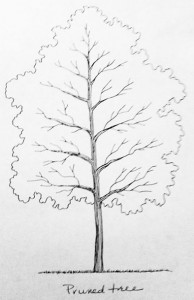
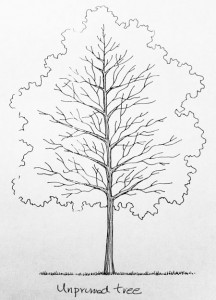 Sometimes young trees develop two central stems. Careful removal of one of them while the tree is young will assure the development of a single strong trunk (or leader).
Sometimes young trees develop two central stems. Careful removal of one of them while the tree is young will assure the development of a single strong trunk (or leader).- Sometimes low branches need to be removed. Because trees grow by adding height and new branches at their tops, very low branches will always be too low. Remove them to allow for passersby, planting under the tree and mulching.
- Sometimes certain lateral branches develop at such a narrow angle to the tree trunk that they are vulnerable to breakage in the future. They are unsuitable to be scaffold branches for the adult tree. Remove them when the tree is young.
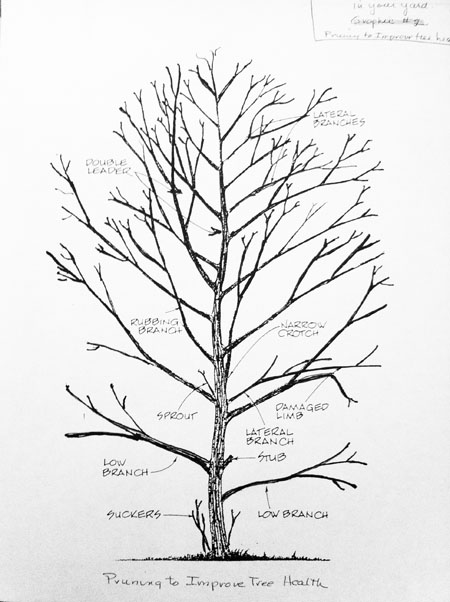 Pruning to improve the health of a tree
Pruning to improve the health of a tree
- Prune away any dead, diseased or injured branches from a tree as soon as you notice them.
- Prune off one of a pair of branches that are rubbing against each other. This will prevent wounds in the tender bark from the abrasions that may admit pests or diseases.
- Prune off twigs and branches that are aiming inward toward the tree trunk, rather than outward.
- Selectively prune off certain branches where there are many crowded together. This will permit better air and light access to the tree and improve the tree’s health and appearance.
Pruning to manage the growth of a tree.
- The time of year when you prune will influence a tree’s growth. Many homeowners who are trying to control the growth of a tree do not realize that pruning its branches in the late winter when it is ending dormancy actually stimulates its growth when spring arrives.
- Conversely, pruning a tree in the summer tends to slow down its growth rate the following year.
- Thinning branches of flowering trees such as dogwood prior to their bloom time will eliminate lots of buds and thus reduce the number of blooms. Those buds that remain will likely produce larger flowers.
- To avoid having to constantly prune to control the size of a tree that is growing too large for its site, plant new trees in locations that will accommodate their mature size and shape.
When to Prune
How frequently you have to prune depends to some degree on what kinds of trees you have in your yard and where they are planted. Trees that need more pruning:
- have a tendency to develop unattractive sprouting branches
- are marginally hardy in our region
- are fast-growing species
- have weak wood
- develop narrow crotches where the branches connect to the trunk
- are too large for their location
- are planted under utility wires, too close to walls and buildings or hang over roofs and gutters.
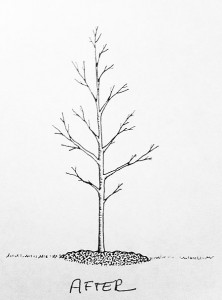
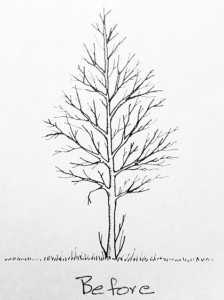 Which season you prune depends on why you are pruning. The timing is especially critical in cases where you want to control the growth of a tree. Also, because ornamental landscape trees flower at various times during the growing season, you do not want to inadvertently prune off the buds before they bloom. Here are some basic guidelines.
Which season you prune depends on why you are pruning. The timing is especially critical in cases where you want to control the growth of a tree. Also, because ornamental landscape trees flower at various times during the growing season, you do not want to inadvertently prune off the buds before they bloom. Here are some basic guidelines.
- Anytime: Prune out dead wood, diseased wood or broken branches anytime during the year. If there are stubs with ragged ends where branches have split or broken off, saw the ends off smoothly at the thickened ridge of bark called the bark branch collar to encourage healing of the wound.
- Mid-Winter: In January or February, well after its leaves have dropped and your tree is dormant, prune to manage and direct the growth of the tree. The branching silhouette of the tree is clearly visible and problem areas are easy to identify. Those places where you make cuts will benefit from the rapid spring growth period and heal over quickly. In fact, pruning now will stimulate growth.
- Mid-Summer: By mid-summer the rapid growth that happens in the spring and early summer has slowed and light pruning to shape a tree can be done. Prune spring flowering trees, such as cherry or dogwood that have finished blooming, fairly promptly. Many will begin forming new buds for next year within a few weeks and you do not want to cut them off.
- Late summer, early fall: Delay pruning any trees that have buds and will not bloom until later in the summer or in the fall, such as crepemyrtles. Prune them after they bloom. Pruning at this time of year is good in situations where you want to reduce the size of a tree.
- Never: Do not prune trees in the spring when the leaves are opening or in the fall when the leaves are falling. At these times a tree’s energy reserves are at their lowest level and are not available to heal the wounds well. Do not prune newly planted trees or transplanted trees. This is no longer recommended.

